Making a Viking Ship
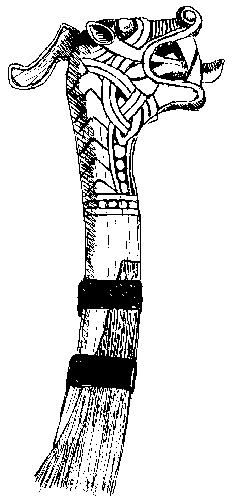
All Viking ships are clinker built; the planks were overlapped at one edge and riveted together. In clinker shipbuilding you start build the outside first, and then put a frame inside it. The other style of wooden shipbuilding, used by the Mary Rose and the Victory, is called carvel. In this style, the frame of the ship is made first, and planks are attached to it. Carvel boatbuilding had been used in Roman times, and was still in use in the Mediterranean in Regia’s period. At the end of the middle ages, Carvel had overtaken clinker as the method of choice for making larger boats. Does this mean that clinker was a poorer method of making boats? Not exactly…
The advantage that carvel has over clinker is that it can be made using any quality of wood, whereas to make a Clinker boat, only the best wood can be used. Carvel boats are built with a strong frame, and the planks are almost there “just” to keep the water out. Because the planks on a clinker-built boat overlap, they add strength to the boat, so the frame can be lighter. It doesn’t have to hold the boat together, just transmit forces between the hull and the “propulsion” – the oars and the sail. The Vikings built their boats using simple tools – it has been said that you can make a Viking boat with nothing but an axe – but they used them in sophisticated ways. They followed the grain of the wood, to get the most strength and flexibility for the lowest weight. Carvel boats tended to be made with sawn timber. Saws are harder to make than axes, and they tend to cut across the grain. This means that they can cut any timber any way you like, but the result will be weaker and less flexible than an axe-cut timber. In general, the Vikings praised their boats for their lightness and flexibility – “Sea Serpent” is a good Viking ship name, and a good Viking ship will ride across the tops of the waves. A heavier carvel boat will tend to fall into them, giving a rougher (and slower) ride.
And the reasons that the clinker tradition stopped being used for larger vessels? Well, no-one is quite sure. However, we know from the Mediaeval ship found in Newport that there wasn’t enough good quality timber to go around. Ships were being built with multiple decks, which needed a heavy frame anyway to carry the cargo – or the new-fangled cannon that warships were starting to mount. The world was changing, and the heavy framed carvel boat was the one that survived that change.
The Master Shipbuilder


The carved tiller from the Oseberg ship (right).
A master ship-builder would set the design for the Viking ship, and he started with the keel. However, it was the two curving posts at the front and the back of the ship – the stem and the stern – which would determine what sort of shape the finished vessel would be. It is from this vital first stage that he got his name – the Stem-smith.
The Stem-smith was probably responsible for making sure that the hull was the correct shape. This would involve cutting planks in ways that seem counter-intuitive to us; seeing the planks out flat can lead you to wonder how they ever could fit together. However, the stem-smith appears to have been an expert in taking a two-dimensional plank and turning it into a three-dimensional ship. It is only with modern computer modelling and an understanding of how boats move through the water that we are starting to see how sophisticated these shapes could be. For instance, Viking ships did not have deep keels, because there were few (if any) harbours that could take them. This meant that, when sailing with the wind anywhere other than right behind them, there was a tendency to be blown off course (mariners call this leeway). By changing the hull section of the boat, what has been called a “negative keel” can be formed – effectively using the boats speed through the water to increase the effect of the keel.
I am not, of course, claiming that Viking boat builders were imbued with supernatural powers, or knew modern hydrodynamic theory. It was simply the culmination of centuries of experimental boatbuilding, with the boats (and possibly boat builders) that survived being copied by the next generation. “Rules of thumb” would have grown up over the years. Plans as we know them would not have been used, although it is possible that a “boat ell” and marked plates and lines could have held useful information. On one of the vessels found being used to block a channel at Skuldelev, in Denmark, it was found that there was a relationship between the length of the keel, the size of the stem post, the number of planks, and the radius of curvature of the plank lines at the stem. Probably many boats, if not most, were built with a set of ideal proportions in the mind of the boat builder.
Wood for Shipbuilding
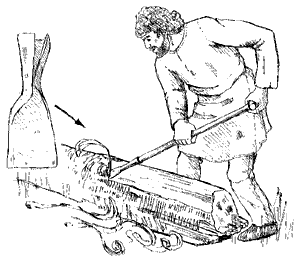
Timber was used green – in other words, shortly after felling. This is different to more modern practice, where the timber is "seasoned" – left to dry for several years. Green wood is easier to work, and more flexible, which can help with some of the more complex shapes found in Viking boats. Wood can be kept "green" for several years by keeping it immersed in water – a stem (or stern) of a Viking style boat was found on the island of Eig in what, a thousand years ago, had been a lake. As it had never been used – there were no indications of rivet holes – it was probably made up when the boat-builder had got a spare piece of suitable timber, and he was waiting for a similar bit for the stern (or stem) which never arrived.
It is also possible to steam green wood without complex equipment like the steam boxes used today. Simply by heating a plank over a fire, the moisture inside the wood heats up and causes the fibres to loosen. This means that – for a few minutes – it can be twisted into shape with less danger of it splitting and breaking. It is highly likely that this was done during Viking times – we know the technique was used to make "expanded" log boats, for example.
Oak or pine were the preferred woods to construct boats from. The only reason for using one over the other appears to be what was growing locally. There is, amongst marine archaeologists, a tentative division of Viking shipbuilding areas into “pine areas” (probably Northern Norway and Sweden) and “oak areas” (Southern Norway, Southern Sweden and Denmark).
Even in the "pine building" regions (mostly Northern Norway) Oak was still the wood of choice for the keel, so it must have been imported from the South. It's likely that masts and yards were made out of pine, so it may have been a two-way trade. The big difference between oak and pine is how planks are made from them. For oak, large straight trees of around two centuries old are cut, and then using wedges split multiple times like slices of a pie – it might be possible to get upwards of 60 planks from one tree. A pine tree will yield only two.
One advantage of pine over oak is that, as they age, pine planks will bend depending on whether the bark side of the plank faces the water or the inside of the boat, so they can be used to enhance the curve of the vessel over time.
The one boat definitely made outside Scandinavia, the “big longship” from Skuldelev in Denmark (Skuldelev 2), is made from Irish Oak. Most of the British Isles was probably an oak building area, although boat builders probably used the nearest timber to hand. Certainly some boats appear to have been repaired with anything, including bits of other boats!
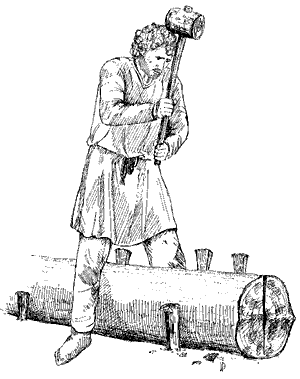
Almost all planks found on Viking boats are made from what is known as “radially split” wood. This type of wood is virtually unknown today – you won’t find it at any timber merchants. It is, however, the strongest way that you can process wood, because it works with the grain of the wood – it gains strength by following the way that the tree grows. The log is split using an axe to make a cut, running up and down the trunk. The split is widened and extended by driving wedges into it, until eventually the whole trunk splits in half.
At this point, for a pine tree, the splitting stops. Younger pine trees are used, which are only about half the diameter of the an oak. Only two planks can be made from a pine tree with any success, and the two halves of the log are now shaved down along their length to remove the curved sections – a very wasteful process – so that they look less like two D’s facing each other and more like two planks. Oak trees can be split further; each half is split into quarters, each quarter split into eighths, and so on. In fact, from a 200-year-old tree, with skill, about 64 planks can be obtained. They are all slightly triangular, and quite rough, so they are smoothed down a little, like the pine planks.
For the frames inside the ships, the Viking shipwrights used another type of timber that is rarely seen today – the grown timber. A grown timber is simply one that has grown to the right shape. The grain runs in the direction that was needed, making the timber incredibly strong.
Viking ship frames are like display cases of grown timbers. For instance, the stem and stern posts would be taken from large, curved branches. Where two parts of the frame are to meet (usually a weak spot that needs re-enforcement) the Vikings used a single timber, cut from a branching element of a tree. On smaller vessels, where the oars didn’t pass through oarholes, the tholes (or rowlocks) were made from the junction of a branch with the trunk – putting the strongest part of the wood at the point of most strain.
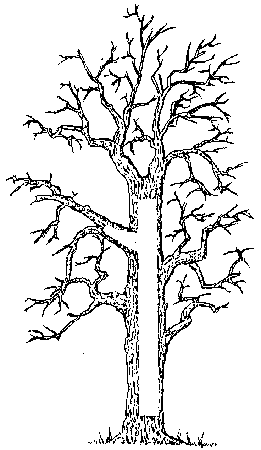
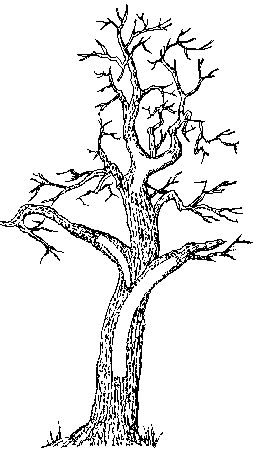
Similar components to be selected from another more twisted and irregular oak tree (right).
Shipbuilding Tools
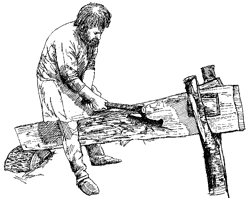
The tools used for this smoothing would appear to us (at first glance) quite simple. An axe with a long blade could be used to smooth, as could an adze and a draw knife. Planes were known, and are shown being used for boat building on the Bayeux tapestry. Later on in the process, augers would start holes for rivets and trenails. Profiled irons would make decorative marks in the planks, or carve channels for caulking.
These apparently simple tools were so good that they remained unchanged for centuries – in fact, until the introduction of modern power tools!
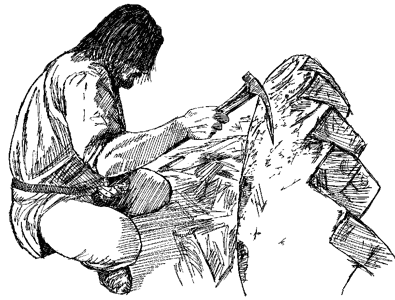
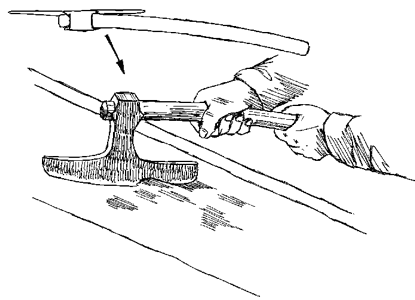
The Sideaxe (right) is used to make split planks flat. It has an offset blade and a 'bent' handle to keep the users hands clear of the work.
Laying the Keel
To make a Viking ship, you lay down a keel first. The keel is made of Oak, as long and as straight as you can get. It’s not a flat piece of wood, but will have a T or a V shape to it, so that the first planks of the hull can be joined to it. Often this shape will change along the length of the keel, changing from a V section at the stem and stern (front and back) to a U section in the middle. This is to help shape the final lines of the hull.
Two pieces of curved wood are attached at the front and back of the keel, the Stem and Stern pieces. They are made from what is called “grown timbers” – wood that has been especially selected because it approximates the shape that is needed. There is some evidence to show that there was a relationship between the length of keel and the diameter of curve in the stem and stern pieces. Viking ships are pretty much symmetrical both fore and aft (front and back) and port and starboard (left and right), so the curve in these pieces will be the same.
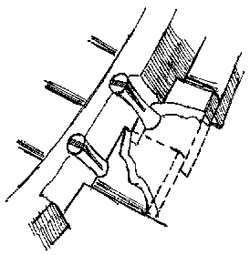
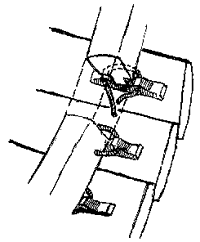
Two types of stem and stern piece construction have been found. In one, the stems are simple curves. In the other, they are carved and notched with steps, forming the beginnings of the planks that they will eventually hold. Although this is a lot of work to do, it can save time in the long run. It was important for Viking ships to have the planks sweeping up and running together along the stems. The Gokstad ship, which has the “simple” stem and stern, has to use much more complex shapes on the planks to achieve the same effect as the later “Skuldelev” ships.
The keel is joined to the stem and stern posts by trenails – wooden pegs, “tree nails” if you prefer. It is then ready to have the planks (or strakes) put on it.
Building the Hull
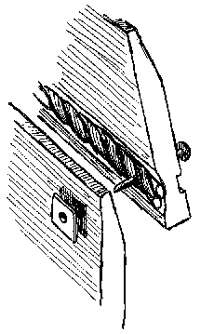
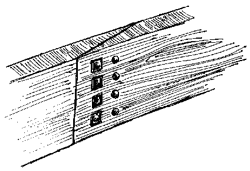
The first strake to go on is called the Garboard strake (dunno why, it just is) and it is riveted and nailed on to the keel. Iron rivets are the most common Viking method of joining planks together (modern clinker boats use copper). Nails are used where the end of the rivet cannot be reached – usually at the stem and stern, where space is tight. The heads of the rivets are bent over rectangular (ish) washers, which are called roves. The next plank is riveted on to the garboard strake, so that it overlaps it when seen from outside. The rivet passes through the outside of the plank near its bottom edge, through the garboard strake near its top edge, and it is bent over a washer inside the boat.
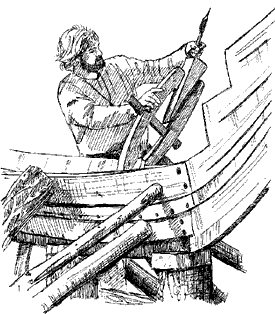
Caulking (or luting) is used to stop water from getting into the boats. No wooden boat can claim to be entirely watertight, but the Vikings did their best. The caulking was made from animal hair (such as sheep’s wool) that had been dipped in a sticky pitch made from pine resin. It was laid in the groove on the plank and, when the plank was riveted to the rest of the boat, created an almost watertight seal, whilst still having the flexibility to move with the boat.
As each plank is riveted to the next, the boat would begin to take shape. To get the boat to the correct profile involves cutting the planks into some fairly strange shapes. The way that the ends of the planks join onto the stem and stern helps determine the profile of the boat – whether it will be a beamy cargo ship or a knife-thin warship. The larger the ship, the more planks will be required. Long ships would require that several shorter planks be joined together by scarf joints – some of which could be quite elaborate. As the planks are added one above the other, clamps were used to hold them in place and the frame inside could be added.
Framing the Ship
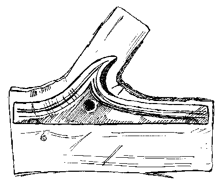
Once the shell is finished, it was time to put the frame into the boat. This is where this method of construction really scores. The frame has the job of transmitting forces from the “propulsion system” (the sail or the oars) to the hull, allowing it to move through the water. The hull is strong in itself – it doesn’t need a heavy frame to keep it together. Boats that are built “frame first” need a heavy frame as it has to deal with all of the forces on the boat – the hull is little more than a waterproof skin.
There are a bewildering number of frame types for Viking ships, dependant (perhaps) on area of construction, time of construction, what the boat was used for, and (probably) what the builder was used to. Most frame systems have ribs that run across the hull, which join to timbers that run across to support a deck. One important part of the frame was a long timber called the keelson. This sat inside the boat on the ribs, just above the keel. It had a hole or slot cut in it to take the mast, and on some of them a branch was left just in front of this hole to act as an extra support. This is another example of a grown timber.
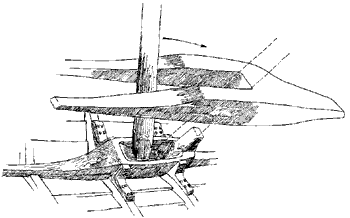
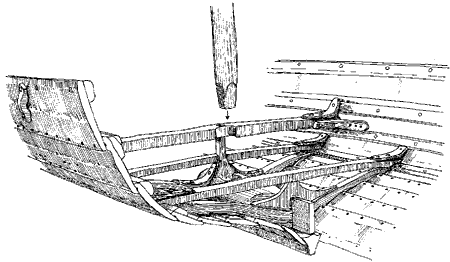
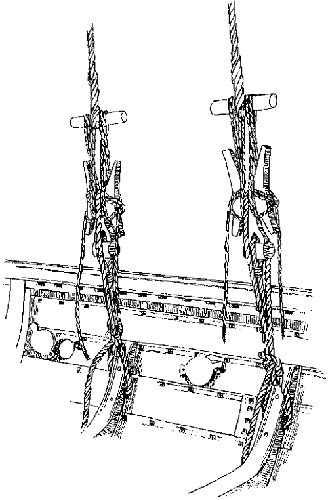
Another style (centre), the reliance on huge timbers to support the mast was replaced by rigging and lateral struts.
An example of some of the rigging using 'Virgins' to help anchor the mast (right).
Related articles on this subject in Regiapædia
- 'Woodworking' - Anglo-Saxon And Viking woodworking techniques.